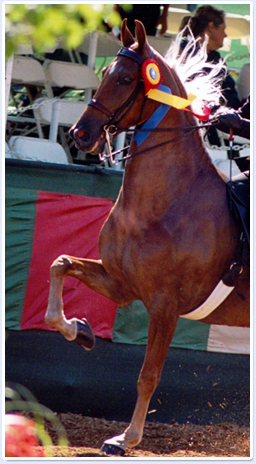Nealia's Articles
Why are the judges so stupid?
By Nealia McCracken
Over the years going to hundreds of shows there is one theme that I frequently hear at each and every show. That is . . . how can the judges be so stupid? Personally I have thought that many times. After hearing this comment enough times it makes you want to investigate to find what actually makes a judge who is a seemingly intelligent person go brain dead while judging the show. My first theory was that the center of the ring forms a vortex similar to that known as the Bermuda Triangle.
This theory would work when any normal person would walk into the center of the arena under the pretext of judging a show and their eyesight and common sense would be severely impaired thus affecting their judgment. After finding absolutely nothing to substantiate this phenomenon I decided there had to be another root cause for our differing opinions.
The first thing I decided was that I needed to know the rules, which I feel very few people take the time to actually do. When reading the rules I quickly figured out (using something I actually learned in school) that the rules can be interpreted in many ways. The USA-E rules are based on a loose constructionist point of view meaning if it doesn’t say you can’t you can. Most judges, in my opinion, tend to fall in this category. An example-while the rules tell you your horse must flat walk they don’t say absolutely positively every step is to be a flat walk. This would allow a judge to take a horse whose is basically perfectly mannered and may have a small babble and still it first. In reality even though it may have bounced walked 3-4 steps 90% of the time it did an acceptable flat walk. Exhibitors and trainers who would be showing against said horse tend to view the rules to favor them over their opponents meaning they would be strict constructionists and would view that bobble as a reason not to tie a horse as they did not flat walk 100% of the required time. As a trainer putting a horse in the ring I would tend to be a loose constructionist in regard to my horse and a strict constructionist regarding competitors’ horses. Spectators also take sides depending on which horse they think should win. This view of rules applies to all rules-quality, suitability, gaits etc.
Another problem I see are people not understanding the rules and applying rules that are from a totally different division or breed of horse. An example is the western division. I feel many people want to apply rules and standards to the western division from other breeds i.e. headset. Way of going and speed instead of taking into consideration that we are riding American Saddlebreds first just under western equipment. While it is my opinion that the American Saddlebred western horse should stay true to our breed form and standards many people feel they should be worked more like a stock breed. This difference of opinion amongst trainers, judges and spectators also creates controversy in judging.
I really started analyzing judging when I started putting customers in the ring. An easy excuse for why a customer horse did not place well is to blame the judging. This point of view, in my opinion, causes more problems in the long run than helping you to obtain better placings for your customers. It is a little like shooting yourself in the foot. After a while if your customers feel the judging is unfair or political all the time they may eventually feel they don’t need to go to a show if they aren’t going to be judged fairly. It is very expensive to show so why waste the money. Another reason this viewpoint/attitude doesn’t help you is that you feel it is never anything you can improve it is always someone else’s fault. These people tend to remain at the same level year after year never improving their showing, training and quality of horses therefore rarely improving their placings.
My big revelation on why the judges tie classes like they did came to me one year while sitting up in Gods country at Louisville where you need an oxygen mask to survive and wondering how year after year the management of the World’s Championship Horse Show could so consistently pick panels of judges that were frequently wrong as the crowds never fail to let them know. The first thing I tried to do was watch one judge and determine which horse got my attention which rider was able to present their horse to make me want to look at it. When I viewed the class from that perspective I noticed horses that weren’t necessarily the best but were presented the best and I started coming closer to the placings of the class. Why is that I wondered. Then I decided I would try and tie 8 places just like the judges did (not just the first three like I normally did). In doing this I realized I didn’t have time to wade through the sea of horses to find absolutely the perfect first place horse who might be buried on the rail or in a pack of horses. What I found was many times the absolutely best horse might not have been shown to its best providing the best visibility to the judge. In this age of showing it is the rider’s responsibility to get the judge to want to write their number on his or her card.
Let’s talk numbers. The average class lasts about 15 minutes. If you have 15 horses showing in that class in theory the judge would have 1 minute to analyze each horse. But wait, we have to go 2 directions of the ring. That gives us 30 seconds per direction. To break it down even further you have a minimum of 3 gaits in each direction, which gives you 10 seconds per gait per horse per class to make a decision. Ten seconds per gait is not much time for a judge to analyze everything. A good rider will present their horse in a fashion that makes the judge want to watch it more then 10 seconds. A poor rider runs the risk of loosing their time and thus not getting tied as high. A rider that enters a class making major mistakes will usually stop the judge
from watching them for the rest of the class so they can eliminate horses and allow more time to analyze the top 8 riders. I encourage everyone to start viewing classes as if they were judging and trying to all 6-8 places. If you really want to test a judge watch only the area they are judging and in most cases you will see your placings will be much closer to the judges. This would also help with junior judging. It is very important to understand that if the judge doesn’t see a horse being blatantly naughty or out of control he can not tie it accordingly. The reverse is also true if a horse is on the rail hidden by four horses even though he is exceptional the judge can’t see him and therefore can’t tie him. One of the pitfalls of getting off the rail to get seen is buzzing around the middle of the ring and actually getting to close for the judge to see you. When you ride exceptionally close to a judge (besides them worrying about their well being) they basically only see your knees and the middle of the horse go by. It is important as a rider to make sure that while you are getting off the rail to get seen you are not getting on top of the judge to where he sees parts of you really close i.e. the reins, bits, slobber on the bit, your knees and the horse’s tail. I encourage my exhibitors to watch as many classes as possible to see what works and doesn’t work in various ring situations. In other words try to view the class from a judge’s point of view rather than a spectator’s point of view. Remember the judges have a job to do and the spectators are there to be entertained. Then take that knowledge and apply it to their classes. I try to encourage my riders not to ride like victims but like victors.
Another comment I hear frequently at shows where they have 3 judges are the cards are all over every place. To me this may be considered a healthy sign for a horse show. First off if you wanted the cards to read 111, 222, 333 etc. in reality you would only need 1 judge because everybody has the same opinion. Second of all most judges pick a zone in the ring to watch. Hopefully each judge will pick a different zone to work. A horse can be consistently good in one area while making all of their mistakes in another resulting in an 11x and have that be very correct. While any people will say the judge that marked that horse off the card is stupid or wrong. Is he truly wrong for tying that horse down for quitting or spinning on the end when no other judge saw him doing it?
I believe the 3 judge system is useful for several purposes. The first reason is the appearance of fairness. It is much harder to influence 3 judges to tie your horse then it is one (I am not saying that it happens). The second is that it balances out opinions. The third reason is if the judges use zones dividing the ring in thirds it gives a truer perspective of the whole ring then one judge judging one area.
In analyzing the rules, the three judge system and all that a judge has to do to tie a class maybe the judges aren’t as stupid as they appear to be at first glance. It is my opinion that as a fund raiser shows should allow individuals to buy a chance to stand in the ring (not near a judge) and tie a class along with them. Then sign their name to the card and post it on the wall so all their friends can see how they judged the class. This would allow the spectators to walk in the judges shoes before criticizing them.
From the limited amount of judging I have done, I can assure you I have always tried to do the right thing and follow the rules. No matter how hard I try there is someone that thinks I am stupid or they are mad at me and usually have no problem in telling me so.
While I don’t think a class looks a lot different from the inside of the ring to the outside of the ring I do think the class looks different if you are trying to tie 6-8 places as compared to picking out a couple.
Why are the judges so stupid? The bottom line is there are differences of opinion, you can’t please everybody, you can’t tie everybody first and after analyzing how the judging of classes work they look a whole like smarter to me. Maybe the only part that makes me wonder how smart the judges actually are is in the fact that they continue to judge while continuing to make people mad at them even while they are trying to do the right thing.




